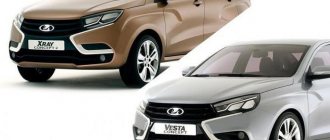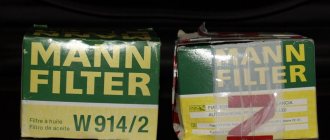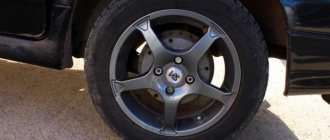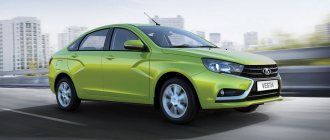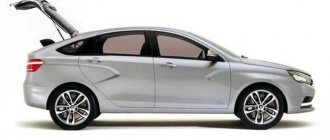In 2015 - 2021 Two new representatives of the VAZ brand were launched on the market - the Lada Vesta sedan and the Lada X-Ray (hatchback). With a slight difference in release time (Vesta - in 2015, X-Ray - in 2021), they quickly gained the trust of car enthusiasts and became rivals to foreign competitors. Possessing sufficient similarities and representing the same AvtoVAZ brand, Vesta and X-Ray became each other’s most avid rivals. It’s difficult to choose, let’s look at how one object of dispute differs from another.
The main differences between VESTA and X RAY
Briefly about each model. Lada Vesta is a sedan, developed from scratch, so a lot of time was spent on design. The model was expected by AvtoVAZ fans, and therefore quickly became popular.
Lada X-Ray is still more of a hatchback body than a crossover, but the issue is debatable. The platform for further development of the model was the Renault Sandero car, so the design took relatively little time. A reliable foundation that has been tested by time has become the strength of XRAY.
Why isn't X-ray a crossover? The lack of all-wheel drive could indicate that the Lada is actually a hatchback, but at the same time, the main difference between the CUV body is the corresponding appearance and high seating position, and all-wheel drive is not always available. What does this mean? That XRAY has both sides, and you have the right to consider it both, because... the question of its body is controversial.
Conclusion
Despite the fact that these two representatives of the Tolyatti concern are assembled on the same platform and have the same units and components in their designs, they are still different. They differ in driving behavior, handling, some little details in equipment and much more. It is impossible to say unequivocally which of them is better, each is good in its own way. The final choice remains with the buyer, who will weigh the pros and cons and choose the best option for himself.
We tried to compare the two most popular domestic cars under the Lada brand: Vesta and XRay. Read on to find out what came of it.
Model specifications
Lada Vesta can be filled with 92-octane gasoline, but its brother is advised to use 95-gasoline, which is more expensive, considering the price of fuel. Both the sedan and the hatchback have front-wheel drive, the same speed - 4200 rpm. and acquired many auxiliary systems: ABS, ESP, etc.
The difference between Vesta is that it has an enlarged tank - 55 liters, the body has one less door than the hatchback - 4 (X Ray has 5), its average consumption is less, only 6.9 liters, but, unfortunately, only 2 airbags.
The Lada X-Ray has a smaller tank - 50 liters, a higher consumption - 7.2 liters, but it has 4 airbags, including side airbags, which Vesta does not have.
Let's look at the main distinguishing characteristics in more detail below.
You can leave reviews about the Lada Vesta sw Cross here
At the right angle
And here I am for the umpteenth time licking my lips at the new VAZ station wagon, and even with increased ground clearance. These marketers are strange people. They attract consumers with teasers of prohibitively expensive cars, as if not knowing that they will be bought solely as a tribute to fashion or prestige. And the “inexpensive” buyer of practical, business models is kept in the dark. Yes, even if they hinted about plans to release Vesta SW, a virtual queue would immediately line up for it. As a result, the Soviet principle of “eat what they give” worked. The expectation that they will buy the car anyway? Risky, if not futile. If previously a station wagon would have had to wait one way or another, today there is a choice, and a potential buyer can even take it the day before the premiere and run to a competitor. With our purchase, we at least remained within the “framework” of the brand. Although they also looked towards other tempting offers.
Was it worth it to “fence” another station wagon with the “Largus” that had existed for several years? Controversial issue. Still, the two models have very different consumer audiences. “Largus” is for those pragmatists who are not interested in design at all. “Vesta” is for connoisseurs of the elegant, those who like to decorate everything that surrounds them. I am sure there will still be many disputes regarding the execution of individual parts, as well as the quality of the car, but even irreconcilable opponents agree that this is a design. In my opinion, there is nothing to criticize the appearance of the “cross” Vesta for at all. A sporty, fast body, somewhat akin to the “barn” SAAB 9-3. Soon the Largus should also receive a front stylized like Vesta.
But people say “don’t drink water from the face.” In the Vesta salon there are much more reasons for criticism and nit-picking. Yes, the interior here is much more modern and attractive than the Largus one, and there’s no need to talk about the Ladas of yesteryear. But once you start looking at Vesta more closely, complaints immediately appear.
The interior materials are “budget”, plus, unfortunately, the build quality is not the best in some places. For example, in the test Vesta the steering column levers were loose, especially the left one. The numbers on the orange scales of the instruments are not the best to read, and in general the scales resemble lambrequins on the windows of long-range trucks. But someone worked on the design, thought through it, offered options... At the same time, there is an alternative, and more than one: fully digital instrument panels have long been developed, not only perfectly readable and extremely functional, but also with the ability to change the design using connected smartphone with the corresponding application downloaded.
Such panels are not cheap. Yes, we are talking about three tens of thousands of rubles. But if we start mass production of these devices, they will become cheaper. Surely owners of Vest from earlier years of production will also want to install the products they like.
The car, produced since 2017, is improving before our eyes. Now the interior has an additional courtesy light. The buttons on the steering wheel and transmission mode symbols shine with an internal light. The multimedia system screen is relatively small and dim, but it is color and touch-sensitive. And the round control knob underneath is logically responsible for the sound volume, and does not serve as a multifunctional joystick, as in the Xray. My wife never gets used to it and, wanting to make the music quieter or louder, constantly switches tracks.
The Vesta has exactly the same climate control panel as the Xray, but here it is located at the right angle, and the symbols on the mini-display are clearly readable. In Xray, the electronic content of the device “shines through” them. In general, Vesta offers a much more “airy” interior than VAZ’s pseudo-crossover, and the view from it is better. And if you climb inside with a tape measure, you will find that in all directions of measurement, the Vesta interior is superior to the Hyundai Solaris interior, although not by much, by 1-2 cm.
The seats in the “Vesta” look more prominent than in the “Solaris”, but when landing you don’t feel this; in the Korean model they are more “grippy”. Plus, the VAZ station wagon pampers rear riders with heated outer seats of the sofa and one USB connector for all to recharge gadgets.
According to the official Lada website, the slowest Vesta SW Cross is with a 1.6-liter VAZ engine and a manual transmission. It accelerates from zero to 100 km/h in 12.6 seconds. The version with a 1.8-liter engine and a manual transmission does this in 11.2 seconds, and the version with a Nissan engine and a CVT does it in 12.2 seconds.
There is no great benefit from folding the back of the rear sofa, even in parts, in the sedan, so this option in Solaris is implemented purely formally, for show. What immediately catches your eye is how much higher the rear surfaces of the folded backrests are than the false trunk floor. In Vesta with the SW prefix, everything is done efficiently and logically. The surface of the “single” cargo space has a flat floor, which is provided by two removable organizing containers - see photo. True, these same organizers are made of foam plastic; if plastic were used here, there would be a little more space in them. By the way, they are also placed on the raised floor panel. In all this there is a sense of practicality and thoughtfulness of solutions. While in the Korean sedan, absolutely non-functional “foam” bars are glued to the false floor of the trunk on the lower side.
In terms of organizing space for luggage, Xray repeats Vesta, but, so to speak, in miniature. However, although the maximum length of the “hold” in it barely exceeds 150 cm, my wife and I managed to organize a sleeping place for two during our trip. How much more spacious it would be in the Vesta station wagon, because in it this figure is more than twenty centimeters larger.
Difference in dimensions between VESTA and X RAY
The width of the models is identical, 1.764 m, but the length is different, Vesta is lower - 1.497 m, than X-ray - 1.57 m, but longer - 4.41 m and 4.165 m for the second model. The sedan's wheelbase is 2,635 m, while the hatchback's is 2,592 m.
In terms of ground clearance, the X Ray wins, it has 19.5 cm, while Vesta has an acceptable figure of 17.8 cm. The trunks differ greatly in volume, Vesta was given 480 liters. capacity, and XRAY is only 361 liters. But you need to take into account the advantageously lower weight of X-ray, which is 1190 kg, when Vesta weighs 1 ton 230 kg.
From all the mentioned indicators, we can conclude that Vesta, due to its greater length and, accordingly, wheelbase, is more comfortable, but the X-ray has increased ground clearance, and therefore greater cross-country ability. And also Vesta with a large trunk is more spacious and convenient for transportation, and the X-ray, in turn, looks larger, although in fact it is lighter, which is also a plus.
3) Dimensions of models
External parameters play an important role. The following are considered the main and priority ones:
Lada Vesta/Lada X-Ray
- Machine length 4,410/4,165 mm; As you can see, Vesta is 245 mm longer than its competitor.
- Machine width 1,764/1,764 mm; Here the cars keep pace.
- Car height 1,497/1,570 mm; This is a winning parameter for the hray, +1 point for the car.
- Wheelbase 2,635/2,532 mm; 2180 is 103 mm ahead.
- Vehicle clearance 178/195 mm; 2180 is a sedan below the X, but the cross bypasses it.
- Trunk volume 480 l./361 l; Plus for 2180.
- Weight 1230/1190 kg. In terms of weight, X outperforms its competitor.
Appearance
The same design idea, similar lines on the body. This decision of designers and engineers is due to the high popularity of Vesta, which is why they wanted to do something similar for 100 percent success. The front parts of the cars are almost the same, similar, including the hood and side parts with “X” patterns, which give the Lada a more modern look.
The sedan is more dynamic, good for young people, it also has better noise and anti-corrosion protection. The Lada X-ray looks solid in appearance, suitable for wealthy people, the front part is slightly shortened. One of the main drawbacks for car enthusiasts is small-diameter wheels, or rather large wheel arches, against which the wheels seem smaller than they actually are. The model should be modified with improved noise protection and wider wheels.
Suspension and handling
The Vesta Cross sedan's ride turned out to be worse than that of conventional sedans - the stiffer suspension and 17-inch wheels with low-profile tires (205/50 R17) are to blame.
But the car turns confidently and without rolls. And no road bumps can throw Vesta off course (which cannot be said about the oncoming air currents from oncoming trucks on country highways).
In terms of handling, Vesta is more playful than Xray, which especially helps on unpaved sections of the road and off-road. The steering wheel responds to even the slightest movement.
Characteristics of VESTA and X RAY
The sedan loses in the number of assortment of units; only one engine is installed on it, which is also available for the X-ray. With a volume of 1.6 liters, 106 horsepower, 4 cylinders and 16 valves, the engine is installed on most models of the brand and is time-tested, therefore it is reliable.
Although Vesta is heavier, it reaches 100 km faster, in just 11.3 seconds, while the crossover will reach the same speed in 11.5 seconds at best. The maximum speed is the same for both cars – 175 km/h.
Consumption is also +/- the same, Vesta will use 9.3 liters in the city, 6.9 liters in the combined cycle, and 5.5 liters on the highway, and the X-ray will “eat” 9 in the urban cycle. 3 liters, the average consumption will be 7.2 liters, and outside the city 5.9 liters.
XRAY has 3 unit options to choose from. Two powerful 1.6 liter engines. and 1.8 l. The first engine developed by the Renault-Nissan concern has 110 hp. and a maximum speed of 184 km/h, and the second 122 hp. and the maximum speed is 2 km/h higher than the previous one.
Lada Vesta Cross or X Ray: comparison of cars
First, let's evaluate the sales level of these models. Since Vesta in the “Cross” version was launched on sale quite recently, we will take sales of regular Vesta sedans and station wagons and compare them with the X-Ray indicators. There is the following data:
- a year after the start of production, the number of Lada Vesta station wagon cars sold reached 8,000;
- Lada is ahead of its competitors in terms of total sales of passenger cars;
- from January to August 2021, Vesta was the second most popular car after the Kia Rio, while the X-ray was only in 9th place. These are the total figures for the Vesta model, including the sedan and station wagon.
The statistics are already giving us pause. On the other hand, these data reflect not so much the quality of the cars sold, but the preferences of the car enthusiasts themselves and their purchasing power.
The average price for Vesta in the Cross version is about 788,900 rubles, while XRay will cost almost 100 thousand cheaper.
And if everything is clear with popularity, then from a price point of view the advantage is clearly not in favor of the Lada Vesta.
Difference in model transmissions
This similarity may seem strange, but there is practically no difference in the gearboxes. Both models are equipped with a 5-speed manual transmission and a robot. The whole difference is in the production. At Vesta, the mechanics are assembled by AvtoVAZ, and the robot is manufactured in France. Unlike X-ray, the gearboxes of which are always French-assembled.
There are no complaints about the mechanics. The robot sometimes switches gears for a long time, which is why there are jerks. But the gears do not slip out, the transmission is quite quiet and precise. The absence of a classic automatic machine is explained in order to reduce costs.
Ride and Handling
The Vesta Cross sedan has the same chassis as the previous SW Cross station wagon and, apart from the body type, there are no significant differences. Their main units are identical, even many body parts are compatible. There is a difference in the suspension design (springs, shock absorbers), and in the bifurcated muffler and plastic body kit, which cannot be installed on a regular Vesta sedan.
The difference in price between just a Lada Vesta and Vesta with the Cross prefix, depending on the version, is 53 – 63 thousand rubles. If you choose between a “cross” sedan and a station wagon, then the cost of the latter will be 32 thousand more expensive - this is a standard surcharge for the two-volume body of the Vesta.
Maximum configuration
Vesta in the “Lux” acquired a 16-diameter casting, all the handles and mirrors are in body color, full power accessories, even rear parking sensors, an audio system with 6 speakers, heated windshields and door lighting when it is opened.
For comfort, the cabin now has air conditioning, climate control, rain and light sensors, a glove compartment with a cooling system, an armrest, an eyeglass case and a mirror in the visor.
How will Xray Vesta respond? It has fog lights at maximum speed, a retractable compartment under the passenger seat, a double floor in the trunk, a heated glove compartment and even enhanced tinting of the rear windows.
Test results
Expert assessments were given based on a number of criteria.
Ergonomics
. Vesta provides good planting geometry. XRAY is worse, despite adjusting the steering wheel for reach and a new seat. Niva is about the same level, but unless you are above average height (the range of seat adjustments is limited). But visibility is better (huge mirrors, powerful headlights). Vesta is let down by wide pillars, and XRAY is let down by small mirrors.
Dynamics
. Vesta accelerates and turns more pleasantly than anyone else. The Niva is slow, but its connection to the gas pedal is much clearer than that of the more dynamic XRAY, which is uncomfortable to drive. Equal scores with the Niva for handling are associated only with the lack of a stabilization system on the Niva - the chassis itself is better tuned. In terms of cross-country ability, there is no equal to the Niva.
Ride comfort
. Despite the additional sound insulation of the Cross version, XRAY turned out to be noisier than Vesta due to the disgusting sound of the engine. Niva in the “civilian” version without a snorkel does not frighten with unnecessary noise at all permitted speeds and is noticeably superior to Crosses in terms of smoothness.
Comfort in the cabin
. Vesta is longer than the others and, as expected, wins over everyone in terms of rear space and trunk volume. And the compartment is well thought out. The Xray and Niva are all more modest, and the Chevrolet transformation is from the last century: to recline the backs of the rear seats, you first need to raise the pillows.
As a result, the total score was calculated, which determined the winner:
Price
Both models are budget, in the basic set Vesta costs 529 thousand rubles, in luxury equipment 672 thousand rubles. If you want to paint your car in the signature lime color, you will have to pay an additional 30 thousand.
For a Lada X-ray in basic equipment you will pay 589 thousand, and in the maximum version 742 thousand. If you want to choose a metallic color, the additional payment will be 10 thousand.
The conclusion is obvious: Vesta is cheaper, given the minimal difference between the trim levels of different models.
Vesta or Khrey, what to choose or what is better, write your opinion in the comments
What's the result?
If you count the number of advantages for each characteristic, then X-ray will win with a slight advantage. But according to a survey of car enthusiasts, the Audience Award goes to Vesta. Because The brand and manufacturer are the same, the build quality of the models is the same, the main difference can be identified - the price of the car.
What does it mean? The choice depends on the preferences and purposes of purchasing a car. XRAY beats its rival, but if you judge individually based on your personal needs and requirements for the car, it may turn out that the urban Vesta is more suitable for you. Therefore, we cannot safely say that Vesta or Xray is better.
If you are young, want to drive around the city, and have a limited budget, choose a sedan. If you are a family member, comfort is important to you, there is a need to travel outside the city, for example to the country, perhaps you want to choose a more powerful engine and have the funds for it, you should take a closer look at the X-ray. In any case, the answer of Vesta or Xray is different for everyone.
Platforms
For the sedan, it is a combination of engines produced by VAZ with gearboxes from Russian and French manufacturers. Also available is a body with a subframe, long stabilizer bars and rear suspension.
As for the X Rey, it is designed on a joint Renault-Nissan platform. It has a simple design with Russian engines and French MT and AMT. It was also equipped with a monocoque body, which has a very large subframe, which is a kind of protection for the engine.
The hatchback platform is reliable, versatile and is 100% suitable for Russian roads, which Vesta cannot boast of.
